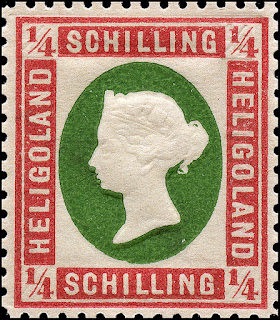Julius Goldner and the Heligoland Reprints
The Berlin reprints
On February 14, 1875, a currency change occurred and the entire remaining stock was bought by the Hamburg dealer Julius Goldner.
The Heligoland Post Office requested new stamps be printed and shipped directly to Goldner. This reprint order was correct and was executed by the Reichsdruckerei according to the order.
In January & September 1879 Goldner bought from the Helgoland government all the plates of Schilling values - so that he now had a monopoly on reprints of all the stamps.
Until 1885, Goldner continued to reprint his plates at the Reichsdruckerei in Berlin with a formal approval from the governor and his successor.
In 1888 O'Brien's successor as governor of Heligoland was Arthur Cecil Stuart Barkly who refused Goldner's approval for further reprints.
The Leipzig reprints
Now that the Reichsdruckerei as reprint supplier was no longer available, Goldner had to look for another printing company. He bought the printing plates legally so that he was able to search for a suitable company on the "free market". In 1888, further reprints "in an unknown, but very large quantity" were produced at the printing company Giesecke & Devrient in Leipzig .
The Hamburg reprints
According to the literature no evidence that Goldner was unhappy with the products of the Leipzig printing. Since he had to deliver his original printing plates for each reprint of the printing company, it saved time and money to commission a printing house in his native Hamburg instead of in the distant Leipzig.
The Hamburger printers, F. Schlotke & Co. printed from 1891 to 1895 in four editions more reprints, along with a large quantity of variants.
The fantasy prints
From 1888 Goldner had all the waste from the printing house delivered - a source of "rarities" such as stamps with inverted centers, odd perfs, bogus color errors.
The genuine Stamps
 |
| Mi 1 TI |
 |
| Mi 1 TII |
 |
| Mi 2 |
 |
| Mi 3 |
 |
| Mi 4 |
 |
| Mi 6a |
 |
| Mi 7c |
 |
| Mi 8b |
 |
| Mi 8f |
 |
| Mi 9 |
 |
| Mi 10 |
 |
| Mi 11 |
 |
| Mi 12 |
 |
| Mi 13 |
 |
| Mi 14 |
 |
| Mi 15 |
 |
| Mi 16b |
 |
| Mi 17b |
 |
| Mi 18g |
 |
| Mi 19b |
 |
| Mi 20 |
In 1890 the German Government reprinted 200 stamps each of the 5 Pf, 10 Pf, 25 Pf, 50 Pf, 1 Mk & 5 Mk for the German Postal Museum. However, a few made their way into the market. They are extremely rare and generally not listed. I have no samples.
The Berlin Reprints
The Leipzig reprints
The Leipzig perforation holes are smaller than in the originals, making the perforation teeth wider and without points. They are blunt or "Stumpf" in German.
The paper is not meshed and the gum is smooth and thin.
The Hamburg Reprints
All Hamburg perforated reprints have 14 perforations, they are rather easily distinguished fronm the genuine which have 13.5 X 14.5.
The rouletted issues have 10 X 12 roulettes and can thereby be distinguished from the original 10 X 10 roulette issues.
The Hamburger printers, F. Schlotke & Co. printed from 1891 to 1895. They produced great numbers of variants & nonexistent stamps some of which are shown here.
Fournier Reprints
Fournier did not mke these, they were obtained from Goldner.
Forgeries
Most of the forgeries appear to be of Spiro origin. They are not plentiful.













































No comments:
Post a Comment
THANK YOU for the feedback. Your comment will be reviewed and appear on this blog within 24 hours
Do you have any pic to share? Use this code [img]your-image-url-here[/img]